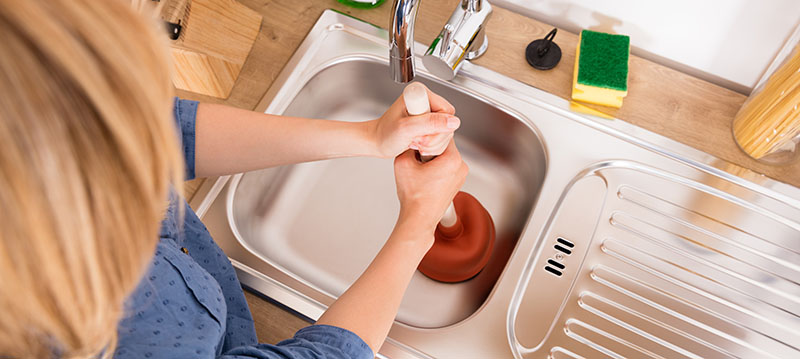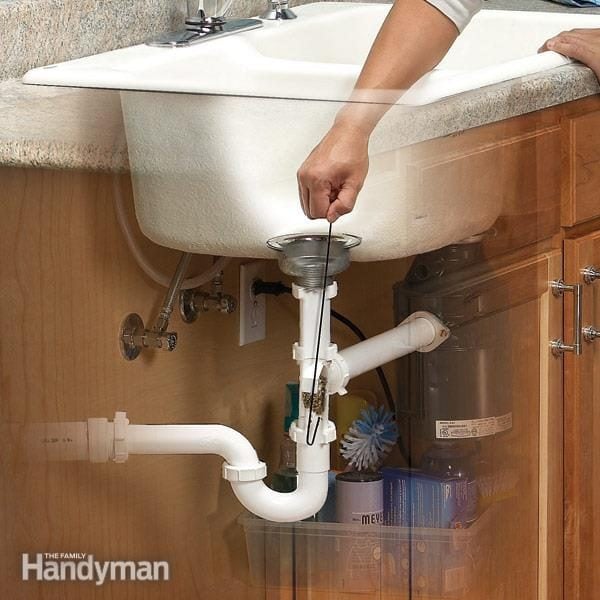5 Effective Do-It-Yourself Solutions for Kitchen Sink Unclogging
5 Effective Do-It-Yourself Solutions for Kitchen Sink Unclogging
Blog Article
Just how do you actually feel in relation to Fixing Typical Household Plumbing Problems?

Clogged kitchen sinks are among the most usual drainage issues house owners face. And what's more, it's a really uncomfortable and undesirable view. Visualize mosting likely to the sink to do your dishes and figuring out that the drain is obstructed and water can not flow down quickly.
Most clogged water drainages are triggered by food particles, fat, oil, and also soap fragments. They clog the sink and also make it hard for water to decrease the drain promptly. While it is tempting to put a call through to the plumbers, there are a couple of DIY hacks you might try first prior to making that phone call.
In this post, we will certainly be taking a look at 5 basic steps you might require to free your kitchen sink from blockages and save you from the pain and shame of dealing with a stopped up kitchen sink.
1. Usage Boiling Water
When faced with a stopped up sink, the first thing you ought to attempt is to pour boiling thin down the drain. That has to do with one of the most simple remedy to stopped up sinks and also drainages. Boiling water assists neutralize the particles and also debris triggering the clog, particularly if it's soap, oil, or oil bits, and also in many cases, it can flush it all down, and your sink will certainly be back to normal.
Because warm water could melt the lines and also trigger even more damages, do not try this approach if you have plastic pipelines (PVC). If you utilize plastic pipes, you might want to stay with making use of a bettor to get debris out.
Utilizing this method, turn on the faucet to see how water streams after putting warm water away. If the clog persists, try the process once again. Nonetheless, the clog could be more persistent in some cases and also require more than just boiling water.
2. Maybe it's the Garbage Disposal
In several instances, the clog might be due to a blockage in the disposal. Usage pliers rather.
You can explore the adhering to alternative to unclog your kitchen sink if this does not work.
3. Attempt a Plunger
If the issue is not from the garbage disposal, you can try making use of a bettor. Plungers are conventional residence devices for this celebration, as well as they can come in convenient if you use them properly. A flat-bottomed bettor is most appropriate for this, however you can make do with what you have is a toilet bettor.
Comply with the list below basic actions to use the bettor successfully:
Secure the drainpipe with a rag and also fill the sink with some warm water
Place the plunger ready over the drain and start diving
Check to see if the water runs freely after a couple of dives
Repeat the process till the drain is free
4. Baking Soda and also Vinegar
Rather than making use of any type of kind of chemicals or bleach, this technique is more secure and not unsafe to you or your sink. Baking soda and also vinegar are everyday residence items utilized for many other points, and they can do the trick to your cooking area sink.
Firstly, remove any water that is left in the sink with a mug.
Then put a good quantity of cooking soda away.
Pour in one mug of vinegar.
Seal the water drainage opening and enable it to settle for some minutes.
Pour warm water away to dissolve various other stubborn residue and also particles.
Following this easy technique can suffice, and you can have your kitchen area sink back. Repeat the procedure as much as you deem needed to clear the sink of this debris completely.
5. Use a Hanger
Using a wire fabric hanger or a plumber's snake if you have one can do the trick. All you need do is correct the alignment of the hanger to go down the drain while you thoroughly choose out the particles triggering the clog.
Run warm water away after this to see how effective you were.
Final Words
Attempting these couple of techniques could save you the costs of having a plumber examine it. However in most cases, a plumber is what we need. In cases where you discover it hard to unblock the sink also after trying all these methods, it may be time to leave it to the specialists.
Get in touch with specialist plumbing firms to fix your water drainage issues and various other various home plumbing needs.
Obstructed cooking area sinks are one of the most typical drainage concerns home owners deal with. Picture going to the sink to do your recipes as well as finding out that the drainpipe is blocked and water can not move down easily.
They obstruct the sink as well as make it hard for water to go down the drain rapidly. When faced with a stopped up sink, the first point you must try is to put boiling water down the drain. Boiling water aids neutralize the particles as well as particles causing the blockage, especially if it's soap, grease, or oil fragments, as well as in numerous instances, it can purge it all down, and your sink will certainly be back to normal.
How to Unclog a Kitchen Sink
Take the Plunge
Start your efforts by plunging. Use a plunger with a large rubber bell and a sturdy handle. Before getting to work on the drain, clamp the drain line to the dishwasher. If you don t close the line, plunging could force dirty water into the dishwasher.
Fill the sink with several inches of water. This ensures a good seal over the drain.
If you have a double sink, plug the other drain with a wet rag or strainer.
Insert the plunger at an angle, making sure water, not air, fills the bell.
Plunge forcefully several times. Pop off the plunger.
Repeat plunging and popping several times until the water drains.Clean the Trap
The P-trap is the curved pipe under the sink. The trap arm is the straight pipe that attaches to the P-trap and runs to the drain stub-out on the wall. Grease and debris can block this section of pipe. Here s how to unclog a kitchen sink by cleaning out the trap:
Remove as much standing water from the sink as possible.
Place a bucket under the pipe to catch the water as it drains.
Unscrew the slip nuts at both ends of the P-trap. Use slip-joint pliers and work carefully to avoid damaging the pipes or fasteners.
If you find a clog, remove it. Reassemble the trap.
If the P-trap isn t clogged, remove the trap arm and look for clogs there. Run the tip of a screwdriver into the drain stub-out to fetch nearby gunk.Spin the Auger
With the trap disassembled, you re ready to crank the auger down the drain line.
Pull a 12-inch length of cable from the auger and tighten the setscrew.
Insert the auger into the drain line, easing it into the pipe.
Feed the cable into the line until you feel an obstruction. Pull out more cable if you need to.
If you come to a clog, crank and push the cable until you feel it break through. The cable will lose tension when this happens.
Crank counterclockwise to pull out the cable, catching the grime and debris with a rag as the cable retracts.

We were shown that article on Fixing Typical Household Plumbing Problems through a good friend on a different web blog. You should take the time to share this blog post if you liked it. Many thanks for your time. Come back soon.
Click Here! Report this page